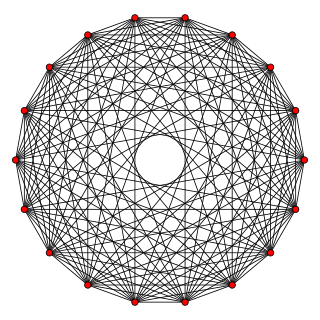Top Qs
Timeline
Chat
Perspective
9-orthoplex
Convex regular 9 dimensional polytope From Wikipedia, the free encyclopedia
Remove ads
In geometry, a 9-orthoplex or 9-cross polytope, is a regular 9-polytope with 18 vertices, 144 edges, 672 triangle faces, 2016 tetrahedron cells, 4032 5-cell 4-faces, 5376 5-simplex 5-faces, 4608 6-simplex 6-faces, 2304 7-simplex 7-faces, and 512 8-simplex 8-faces.
It has two constructed forms, the first being regular with Schläfli symbol {37,4}, and the second with alternately labeled (checkerboarded) facets, with Schläfli symbol {36,31,1} or Coxeter symbol 611.
It is one of an infinite family of polytopes, called cross-polytopes or orthoplexes. The dual polytope is the 9-hypercube or enneract.
Remove ads
Alternate names
- Enneacross, derived from combining the family name cross polytope with ennea for nine (dimensions) in Greek
- Pentacosidodecayotton as a 512-facetted 9-polytope (polyyotton). Acronym: vee[1]
Construction
There are two Coxeter groups associated with the 9-orthoplex, one regular, dual of the enneract with the C9 or [4,37] symmetry group, and a lower symmetry with two copies of 8-simplex facets, alternating, with the D9 or [36,1,1] symmetry group.
Cartesian coordinates
Cartesian coordinates for the vertices of a 9-orthoplex, centered at the origin, are
- (±1,0,0,0,0,0,0,0,0), (0,±1,0,0,0,0,0,0,0), (0,0,±1,0,0,0,0,0,0), (0,0,0,±1,0,0,0,0,0), (0,0,0,0,±1,0,0,0,0), (0,0,0,0,0,±1,0,0,0), (0,0,0,0,0,0,±1,0,0), (0,0,0,0,0,0,0,±1,0), (0,0,0,0,0,0,0,0,±1)
Every vertex pair is connected by an edge, except opposites.
Images
Notes
References
External links
Wikiwand - on
Seamless Wikipedia browsing. On steroids.
Remove ads









